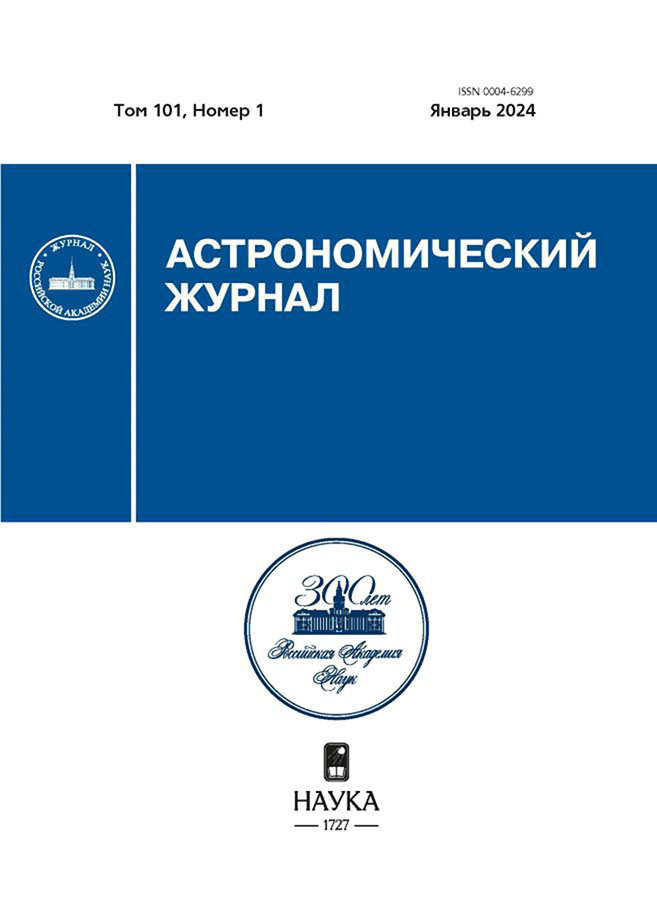MHD modeling of the molecular filament evolution
- Autores: Sultanov I.M.1, Khaibrakhmanov S.A.2,1,3
-
Afiliações:
- Chelyabinsk State University
- Saint Petersburg State University
- Ural Federal University
- Edição: Volume 101, Nº 1 (2024)
- Páginas: 34-41
- Seção: Articles
- URL: https://cardiosomatics.ru/0004-6299/article/view/647589
- DOI: https://doi.org/10.31857/S0004629924010044
- EDN: https://elibrary.ru/LFUCTV
- ID: 647589
Citar
Texto integral
Resumo
We perform numerical magnetohydrodynamic (MHD) simulations of the gravitational collapse and fragmentation of a cylindrical molecular cloud with the help of the FLASH code. The cloud collapses rapidly along it’s radius without any signs of fragmentation in the simulations without magnetic field. The radial collapse of the cloud is stopped by the magnetic pressure gradient in the simulations with parallel magnetic field. Cores with high density form at the cloud’s edges during further evolution. The core densities are n ≈ 1.7×108 and 2×10-7 cm–3 in the cases with initial magnetic field strengths B = 1.9×10-4 and 6×10-4 G, respectively. The cores move toward the cloud’s centre with supersonic speeds |vz| = 3.6 and 5.3 km/s. The sizes of the cores along the cloud’s radius and cloud’s main axis are dr = 0.0075 pc and dz = 0.025 pc, dr = 0.03 pc and dz = 0.025 pc, respectively. The masses of the cores increase during the filament evolution and lie in range of ≈(10-20)Me. According to our results, the cores observed at the edges of molecular filaments can be a result of the filament evolution with parallel magnetic field.
Palavras-chave
Texto integral
Sobre autores
I. Sultanov
Chelyabinsk State University
Autor responsável pela correspondência
Email: syltahof@yandex.ru
Rússia, Chelyabinsk
S. Khaibrakhmanov
Saint Petersburg State University; Chelyabinsk State University; Ural Federal University
Email: syltahof@yandex.ru
Rússia, Saint Petersburg; Chelyabinsk; Yekaterinburg
Bibliografia
- P. André, J. Di Francesco, D. Ward-Thompson, S.-I. Inutsuka, R. E. Pudritz, and J. E. Pineda, Protostars and Planets VI, edited by H. Beuther, R. S. Klessen, C. P. Dullemond, and T. Henning, (Tucson: University of Arizona Press, 2014), p.27.
- A. E. Dudorov and S. A. Khaibrakhmanov, Open Astronomy 26(1), 285 (2017).
- V. Konyves, P. André, A. Men’shchikov, P. Palmeirim, et al., Astron. and Astrophys. 584, id. A91 (2015).
- D. Ward-Thompson, K. Pattle, P. Bastien, R. S. Furuya, et al., Astrophys J. 842(1), id. 66 (2017).
- A. Hacar, S. E. Clark, F. Heitsch, J. Kainulainen, G. V. Panopoulou, D. Seifried, and R. Smith, Protostars and Planets VII, ASP Conf. Ser. 534, Proc. of a conference held 10–15 April 2023 at Kyoto, Japan; edited by Shu-ichiro Inutsuka, Y. Aikawa, T. Muto, K. Tomida, and M. Tamura (San Francisco: Astron. Soc. Pacific, 2023), p. 153.
- P. Bastien, Astron. and Astrophys. 119(1), 109 (1983).
- L.K. Dewangan, L.E. Pirogov, O.L. Ryabukhina, D. K. Ojha, and I. Zinchenko, Astrophys. J. 877(1), id. 1 (2019).
- S. Chandrasekhar and E. Fermi, Astrophys. J. 118, 116 (1953).
- J. S. Stodolkiewicz, Acta Astronomica 13, 30 (1963).
- J. Ostriker, 140, 10⁵6 (1964).
- Shu-ichiro Inutsuka and S. M. Miyama, 480, Astrophys. J. 681 (1997).
- Y. Shimajiri, P. André, N. Peretto, D. Arzoumanian, E. Ntormousi, and V. Konyves, Astron. and Astrophys. 672, id. A133 (2023).
- O.L. Ryabukhina, M. S. Kirsanova, C. Henkel, and D. S. Wiebe, Monthly Not. Roy. Astron. Soc. 517(4), 4669 (2022).
- D. Seifried and S. Walch, Monthly Not. Roy. Astron. Soc. 452(3), 2410 (2015).
- A.E. Dudorov and S. A. Khaibrakhmanov, Astrophys. Space Sci. 352(1), 103 (2014).
- A. E. Dudorov and Yu. V. Sazonov, Nauchnye Informatsii 63, 68 (1987).
- B. Fryxell, K. Olson, P. Ricker, F. X. Timmes, et. al., Astrophys. J. Suppl. 131, 273 (2000).
- B. van Leer, J. Comput. Phys. 32(1), 101 (1979).
- J. Barnes and P. Hut, Nature 324(6096), 446 (1986).
- C. Federrath, R.S. Klessen, L. Iapichino, and J.R. Beattie, Nature Astron. 5, 365 (2021).
Arquivos suplementares
















